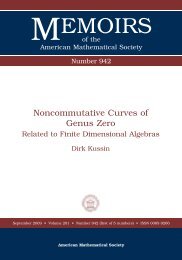University of Paderborn Department of Mathematics Diploma Thesis ...
University of Paderborn Department of Mathematics Diploma Thesis ...
University of Paderborn Department of Mathematics Diploma Thesis ...
Create successful ePaper yourself
Turn your PDF publications into a flip-book with our unique Google optimized e-Paper software.
4.7. COMPUTING ALL HILBERT FUNCTIONS TO A HILBERT POLYNOMIAL 119p R/I (i). This algorithm is more efficient than that sketched above.The following lemma suggests, how we find such an upper bound, such that the value <strong>of</strong>the Hilbert function equals the value <strong>of</strong> the Hilbert polynomial.Lemma 4.26. Let I ⊂ R be a saturated homogeneous ideal, h R/I the Hilbert functionand p R/I (z) the Hilbert polynomial <strong>of</strong> R/I. Let k > 0 denote the degree <strong>of</strong> the last monomialgenerator <strong>of</strong> the lexicographic ideal L p associated to p R/I (z) by Theorem 2.25. Thenh R/I (i) = p R/I (i) for all i ≥ k.Pro<strong>of</strong>. By Theorem 2.21, there is a unique lexicographic ideal L H associated to the Hilbertseries H R/I (t) <strong>of</strong> R/I, such that h R/I (i) = h R/LH (i) for all i ∈ Z. By Corollary 3.40,we know that the Hilbert function h R/Lp <strong>of</strong> R/L p is minimal among all Hilbert functionsassociated to the Hilbert polynomial p R/I (z). If k denotes the degree <strong>of</strong> the last monomialgenerator <strong>of</strong> L p , then by Remark 1.20 and by Gotzmann’s Persistence Theorem 2.31, weobtain h R/Lp (i) = p R/Lp (i) for all i ≥ k. In the pro<strong>of</strong> <strong>of</strong> Corollary 3.40 we saw thath R/LH (i) ≥ h R/Lp (i) for i < k and h R/LH (i) = h R/Lp (i) for all i ≥ k. Hence, we obtainh R/I (i) = h R/LH (i) = h R/Lp (i) = p R/Lp (i) = p R/I (i)for all i ≥ k, which proves the assertion.Now we combine the above lemma with Remark 4.25 to give an efficient algorithm (firstin pseudo code and later in source code) to compute the values <strong>of</strong> a Hilbert function froma given Hilbert series.Algorithm 4.27. Let H R/I (t) =g(t) be the reduced Hilbert series <strong>of</strong> R/I for I ⊂ R(1 − t)da saturated homogeneous ideal, g(t) and d as in Remark 4.25.Input. A reduced Hilbert series H R/I (t) and i > 0.1. Compute the Hilbert polynomial p R/I (z) <strong>of</strong> R/I from H R/I (t).2. Compute k, the degree <strong>of</strong> the last monomial generator <strong>of</strong> the unique lexicographicideal L p associated to p R/I (z).3. For j < k use the formulas stated in Remark 4.25 to compute h R/I (j).4. For k ≤ j ≤ i compute h R/I (j) = p R/I (j).Output. h R/I (j) for 0 ≤ j ≤ i.Pro<strong>of</strong>. (Correctness) The algorithm works correct by Remark 4.25, where we showed, howwe can obtain the values h R/I (j) for 0 ≤ j ≤ k − 1, and by Lemma 4.26, which guaranteesthat h R/I (j) = p R/I (j) for all j ≥ k.
















